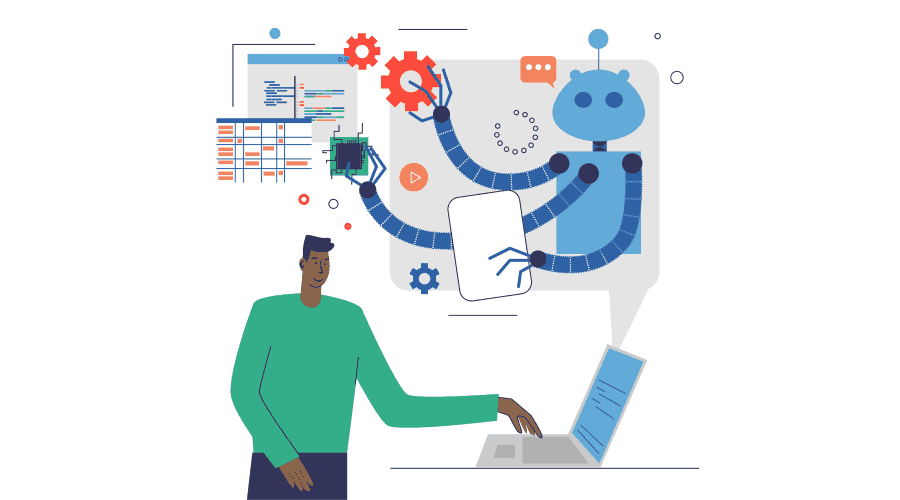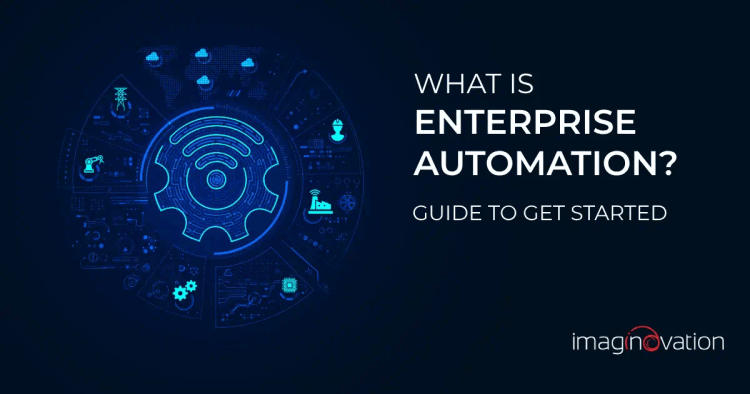It's no secret - enterprise automation ensures rapid transformation in today's business landscape. It allows organizations to embark on a path that delivers end-to-end workflow automation.
Why do you need to adopt it as a strategic approach? It's simple! Automation can help drive speed, scale, and success. Plus, it's an enabler of business growth.
Are you ready to harness the full potential of end-to-end automation? Tag along! In this article, we will explore various aspects of enterprise automation. Plus, we will delve into its benefits and help you get started.
Understanding Enterprise Automation
Gartner predicts that 69% of routine managerial work will be entirely automated by 2024. The numbers speak volumes! If your company is handling manual and repetitive tasks, it's time you consider embracing automation. Let's start with some basics.
Enterprise automation focuses on using technology and software to streamline and optimize business processes within an organization. The goal is simple - it works on reducing manual efforts, enhancing efficiency, and improving overall productivity.
How?
The logic involves automating repetitive tasks, workflows, and business processes across different departments and functions within an organization.
It often uses technologies such as robotic process automation (RPA), artificial intelligence (AI), machine learning (ML), and other advanced software solutions. Disruptive technologies help leverage various types of automation.
Moreover, enterprise automation profoundly impacts business efficiency, productivity, and scalability by optimizing processes, reducing manual intervention, and enabling organizations to adapt more effectively to changing demands.
Here's an exciting statistic - 73% of IT leaders believe automation saves about 50% of the time. Furthermore, 51% of leaders add that automation can reduce costs by 10% to 50%.
According to another report, experts estimate that automating different tasks can raise productivity growth to 1.4% annually. The statistic highlights the increasing significance of adopting enterprise automation solutions for an organization to stay competitive.
Types of Enterprise Automation
There are four types of enterprise automation. Let's go through each of them and see how they are useful for different use cases.
Basic automation
Take a moment to think of the smallest building block of a complex automation system! Let's say using spreadsheet formulas. Basic automation is the use of software to handle simple tasks. The software may use low - or no-code, often enough to address the data management needs.
Typically, basic automation is the building block of larger automated systems. Some common examples of basic automation across departments include:
Finance & Accounting: Involves automating financial processes, such as invoice processing, expense management, and financial reporting. It helps reduce errors, ensure compliance, and improve the speed of financial transactions.
- HR: Focuses on automating various HR processes, including recruitment, onboarding, employee records management, and performance evaluation. It helps streamline HR tasks, reduce paperwork, and improve overall efficiency.
- Marketing and Sales: Monitor brand and competitor analytics and set up news alerts. For sales, create and set up custom dashboards where sales reps can view their daily progress.
- IT: Writing bash scripts to automate repetitive tasks, developing system maintenance scripts, constructing deployment pipelines, etc.
Security and Compliance Automation: Focuses on automating cybersecurity-related tasks, compliance monitoring, and threat detection. It includes tasks like security event logging, compliance reporting, and automated response to security incidents.
Document Management Automation: Streamlines the creation, storage, retrieval, and distribution of documents within an organization. It includes features such as document capture, version control, and automated document workflows.
Business Process Automation (BPA)
Business process automation (BPA) uses software to automate and streamline multi-step workflows and processes across teams within an organization. The automated solutions help seamless collaboration and coordination among team members.
The goals of BPA include boosting operational efficiency, reducing errors, standardizing processes, and freeing up staff time from mundane tasks to focus on more strategic value-added activities. Further, the solutions can deliver many benefits, including enhanced productivity, fewer errors, and improved process consistency.
Integration Automation
Integration automation solutions allow technology to transfer data between different systems and applications automatically. The transfer of data can be between different software platforms or different departments of your organization.
Let's look at an example - consider you've placed an order for a pair of running shoes on Amazon. On purchase, Amazon integrates real-time order data and logistics information. Thus, one can track the shipping process and receive an accurate projection of when the package will arrive.
Robotic Process Automation (RPA)
Robotic process automation (RPA) is the use of software bots that can perform repetitive, rule-based digital work more accurately and efficiently than humans.
The bots are governed by business logic and structured inputs, helping emulate human actions and interact with applications and systems to perform tasks such as data entry and extraction, form filling, and report generation. Automation technology is transforming the way organizations operate.
Benefits of Using Enterprise Automation
Enterprise automation can significantly benefit the efficiency and competitiveness of your business. It is a massive help to organizations that want to streamline processes, reduce costs, and boost efficiency.

Streamline Workflows
Organizations strive to enhance operational efficiency and productivity in today's fast-paced business landscape. Here automation helps:
- Focus on strategic activities: Firstly, it helps in automating repetitive and time-consuming tasks. Thus eliminating mundane tasks and supporting employees to focus on more strategic and value-added activities.
- High-quality output: Moreover, automation reduces errors and minimizes the need for human intervention, increasing the accuracy and quality of outputs.
- Boost cost savings: It optimizes resource allocation, which results in cost savings and better resource utilization.
Increase Employee Productivity
- More satisfaction: According to a research study, 90% of workers claim automation solutions increased their productivity and have made them much more satisfied with collaboration across departments.
- Focus on personal growth, and learning new skills: In another research study, nearly 80% of employees reported that automation gave them more time to deepen relationships with customers and other stakeholders. The solutions helped them take on challenging new projects, and learn new skills.
- Reduces burnout: The solutions help combat burnout and improve work-life balance.
Improve Customer Experiences
- Highly personalized customer experiences: Real-time data, automation, and AI help deliver highly personalized customer experiences. The AI insights turn into recommendations, creating an impact for customers.
- Deepens customer relationships with brands: Automation bolsters customer experiences, catering to customers' changing needs and grounding engagement in trust.
Improve Decision Making
- Identify patterns and trends: Automation and AI can be used to analyze large amounts of real-time data to identify patterns and trends that humans may be unable to see. The insights can be used to make better decisions. For example, AI can predict customer behavior so businesses can effectively target their marketing campaigns.
- Identify potential risks: Automation solutions can assess and analyze various risk factors, helping to identify potential risks and devising effective mitigation strategies.
Achieve Better Audibility and Accountability
- Relevant evidence: With enterprise automation solutions, achieving greater audibility and accountability is easy. Further, there is proper evidence that the activities carried out have reached the desired outcomes.
How to Prepare Your Organization for Enterprise Automation
Preparing your organization for enterprise automation involves a blend of strategic planning, technology adoption, and cultural shifts.
Identify Tasks Best Fit for Automation
Start with brainstorming on tasks, processes, workflows, or activities that can benefit from automation. You’re right - not all tasks are technically feasible! A good rule of thumb is to check repetitive automation tasks and follow a set of rules or patterns.

Get Innovative
Automate with the future in mind, and encourage employees to learn niche technological skills. Plus, focus on supporting them in developing empathy, creativity, leadership skills, and people management skills because these are skills that machines may not master soon.
Create an automation center of excellence
Setting up an automation center of excellence (COE) is a future-forward step. The COE's vision will be to help you create the roadmap for the development and launch of your automation efforts. Plus, the team can consider inviting key people from IT and the business areas to help make decisions that are best for the future.
Focus on Inclusive and Diverse Design
Applying diversity, equity, and inclusion initiatives is the need of the hour. Businesses need to consider the diverse needs of their customers. Plus, it is critical to develop and nurture these practices internally.
Select the Right Automation Tools
Research and select the most relevant automation tools that align with your organization's needs. Consider tools for robotic process automation (RPA), business process management (BPM), artificial intelligence (AI), and machine learning (ML).
If you plan to develop game-changing enterprise automation solutions and are not sure, you can choose to select vendors with a stellar reputation such as Imaginovation, who can act as your trusted business advisors.
How to Implement Enterprise Automation in Your Organization
Now that we've established the importance of automation for enterprise businesses, let's dive into the practical steps you can take to implement these systems in your organization.
The process can seem complex, but breaking it down into manageable stages can help ensure a smooth transition. Follow these guidelines to embark on your automation journey effectively and efficiently
1. Define Objectives and Scope
Firstly, clearly define the objectives of automation. Determine the scope of automation, considering both short-term and long-term goals. Once you know the scope and the right technology for automating the task, you must closely examine the costs involved.
2. Calculate Costs and ROI
When evaluating the costs of implementing automation, consider software licensing, infrastructure requirements, and training costs. Remember to include other costs on implementation services, maintenance and support, third-party automation integration costs, etc.
It will help to set specific goals that can help reduce process time or increase accuracy. When calculating ROI, consider assigning monetary values to the identified savings. Ensure that your estimations are accurate because such measures will make it easier to map the success of your implementation.
3. Gain Leadership Support and Collaborate with Everybody

It is a must to obtain support from top-level executives and leadership. Ensure they understand the benefits of automation and its holistic alignment with the overall business strategy.
Further, get everybody on the same page, which may include your department heads, IT teams, and end-users. The key to a smooth transition is through effective collaboration and communication.
4. Design and Build the Automation Workflows
Work closely with your team or development partner to sync the decision points, steps, and data flow involved in each process. Ensure that you leverage the selected automation tools to create efficient and effective workflows that align with your business requirements.
Consider an agile methodology as it brings together cross-functional teams that plan, test, implement, and redesign automated processes in quick release cycles.
5. Integration with Existing Systems
Ensure that the automation solutions can seamlessly integrate with existing IT systems and applications; compatibility is crucial for a smooth implementation.
6. Data Security and Compliance
Establish robust security measures to protect sensitive data, ensuring compliance with relevant regulations and standards. Further, it's essential to consider encryption, access controls, and regular audits.
7. Employee Training and Upskilling
According to a survey, 57% of employers believe automation’s primary goal is to enhance employee performance. Thus, it is vital to train employees on how they’ll transition to new roles, providing training programs to help them adapt to the changes brought about by automation. Upskilling initiatives can empower them to work alongside automated systems.
Cultural Transformation
It will help to foster a culture that embraces change and innovation. Communicate the benefits of automation transparently, addressing any concerns and highlighting the positive impact on job roles.
Scale Gradually
Implement mechanisms to monitor the performance of automated processes. Regularly evaluate the results and gather feedback for continuous improvement. Ultimately, consider gradually scaling the automation initiatives, unlocking efficiency gains, and positioning your organization for future growth and innovation.
Wrapping Up
Enterprise automation can smartly amalgamate niche technologies and offer a unified and sustainable platform relevant to your business needs. Jumpstart and achieve phenomenal success with enterprise automation solutions, making your business processes and functions smarter. It's time you consider automating and scaling your business and win that competitive advantage.
Automate Your Enterprise Business Processes With Imaginovation
A robust enterprise automation solution can help run your business processes more efficiently, boosting exceptional customer experience. If you’re trying to decide where to start and how to ensure a successful enterprise automation deployment, talk to us.
We are an award-winning web and mobile app development company in Raleigh with remarkable experience developing high-quality enterprise automation solutions.
Let’s talk.
Ready to build an app, but not sure where to start?
We've got you covered. Click the button below to get started.





